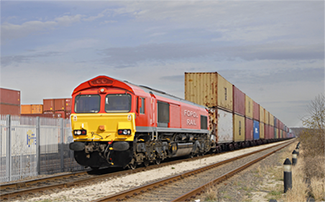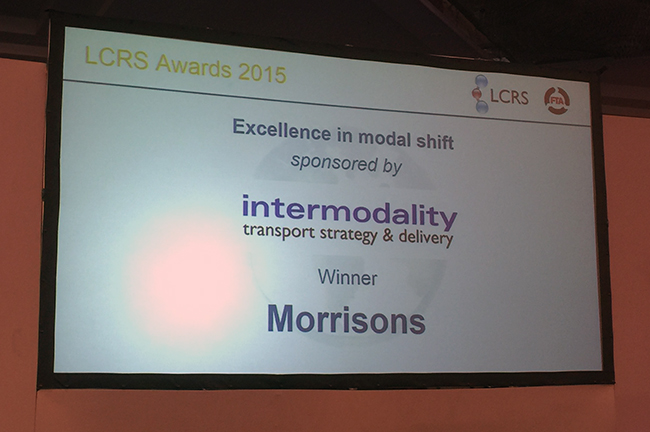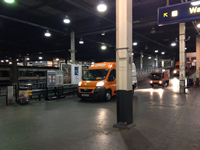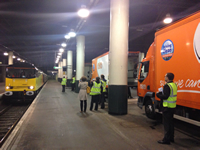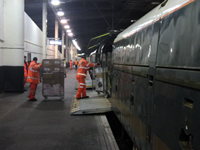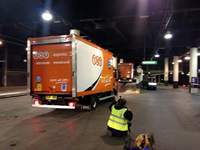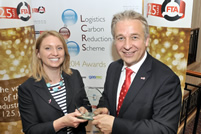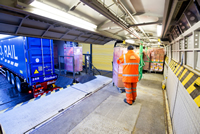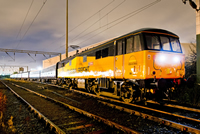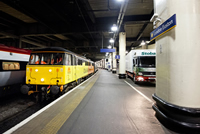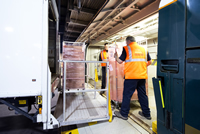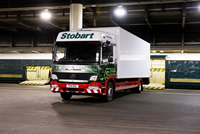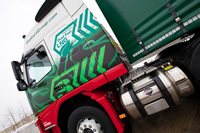
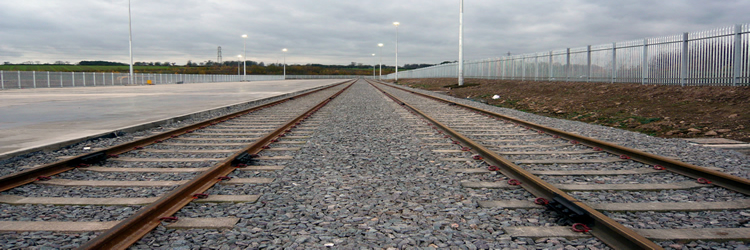
Our role: project management support for terminal construction
1 April 2017 Historic moment for UK rail freight as double stack container trains launched
This morning saw the first ever double-stack container train to be seen in the UK, courtesy of new open-access rail freight operator Fopol Rail. The 750 metre train formed of 37 wagons can carry 74 x 40' length containers, dramatically increasing the carrying capacity of a single train and taking a record-breaking number of lorries off the road network. Welcoming this dramatic development for UK and European rail freight, Lila Porof, Managing Director of Fopol Rail, said:
“North America and the Indian sub-continent have already embraced the step-change in efficiency of rail freight using double-stack intermodal trains. We are therefore delighted at being first to market with launching double-stack operations in Europe, and based on our assessment of routes capable of accommodating such trains in the UK, we will be now be able to offer services on several key intermodal corridors in the coming months.”
Fopol Rail's emerging network of W13-gauge short-line routes (subject to confirmation and minor footbridge re-engineering) is expected to include:
• Felixstowe (to Trimley)
• London Gateway (to Thames Haven Junction)
• Southampton Western Docks (internal movements only)
• Tilbury Northfleet Hope terminal (to junction with exchange sidings)
• Boston Docks (to just outside Thorpe Culvert and almost to Sleaford)
• Thamesport to Lower Stoke (A228 overbridge)
• Dungeness branch (Appledore to Lydd)Intermodality is delighted to have helped with the fabrication of this exciting new chapter in the ongoing story of rail freight.
7 July 2016 HS2 recommends a change of route through Sheffield
In 2007 Intermodality assisted client Helioslough roll out 2 new rail-linked warehouses in Sheffield at the SIRFT development, on the site of the former Tinsley marshalling yard. The buildings were subsequently let to Marks & Spencer, with ownership of the site subsequently transferring to CBRE and in turn to London Metric.
The initial route proposals by HS2 through the Sheffield area passed close to the SIRFT site, but would have enabled M&S to maintain its operations. A subsequent change in the alignment through Meadowhall, designed to avoid the Firth Rixson steelworks, introduced a major departure from HS2's own design standards, reducing speeds from 400km/h to 190km/h, and causing the route to pass straight through the SIRFT site - which would have seen the rail-linked warehouses demolished and several hundred M&S staff made redundant.
Working with M&S and London Metric, we produced a series of alternative route options, the objective being to no only reduce the impact of HS2 on SIRFT, but also on a number of adjoining employers, including Harworth Estates (and the biggest single regeneration scheme in the area), Morrisons, Outukumpu and Sheffield Business Park. With close support from Interel and Nathaniel Lichfield & Partners, we assisted London Metric and Harworth to engage with local stakeholders and make the case to HS2, highlighting the scale of local impacts from construction, business disruption and relocation and employment loss, along with presenting alternative route options to minimise impacts and improve deliverability.
We are therefore pleased to note today's recommendation by HS2 to pursue a revised alignment further to the east of Sheffield, with HS2 services able to reach the city centre direct via existing lines - a good example of positive engagement leading to positive outcomes.
28 June 2016 Irish Rail delivers with longer freight trains
In 2013 Intermodality was asked by Irish Rail to carry out a review of its rail freight business which, much like British Rail's 30 years previously, had been in decline for several years. Working closely with Irish Rail staff at all levels, we helped identify opportunities to grow the business once more. One of the key recommendations made in our 2014 report was to move towards operating longer freight trains to help improve efficiency and competitiveness.
Irish Rail set to work undertaking a series of technical studies to determine the capabilities of traction, rolling stock, track and signalling to accommodate longer trains. This has now borne fruit, with test runs of longer timber and intermodal trains, the latter increasing train length by 50% from 18 to 27 wagons, the longest ever operated on the network.
We are delighted to see Irish Rail's freight business achieve a turnaround in traffic over the last few years, this latest development another sign of an increasingly positive, proactive approach to growing traffic and contributing to reductions in lorry traffic and emissions.
For more information on Irish Rail's freight business, click here
1 June 2016 SUEZ goes live with 3 new daily trainload services
Intermodality client SUEZ has commenced start-up operations to its two new rail-served energy recovery facilities at Avonmouth and Wilton, moving waste from West London and Merseyside respectively for conversion into heat and electricity. The long-term contracts with the waste authorities will see a daily train from London and 2 daily trains from Knowsley every weekday, keeping traffic off the road network and creating spin-off opportunities for third-party rail traffic through the network of railheads now operational at Brentford and Northolt in London, Avonmouth in Bristol, Knowsley in Merseyside and Wilton on Teesside.
Intermodality worked alongside SUEZ to help with development of the rail services component of both bid submissions to the Waste Authorities, as well as design input for the new railheads at Avonmouth, Knowsley (converting an existing rail-linked warehouse into a fully-enclosed intermodal terminal). We congratulate SUEZ on this major achievement. delivered with support from Network Rail, DB Schenker Rail UK, Potter Logistics and Sembcorp.
13/05/15 Intermodality presents FTA mode shift award to Morrisons
Today the Freight Transport Association (FTA) hosted its annual Logistics Carbon Reduction Scheme (LCRS) conference and awards event. LCRS is a voluntary industry-led approach, led by the FTA, to reduce carbon emissions from freight transport by recording and reporting reductions in CO2 emissions.
Intermodality again formed part of the the judging panel for the 2015 LCRS awards, took part in one of the workshops at the event, and has once more sponsored one of the 5 awards, for Excellence in Modal Shift, recognising the company which has made the greatest achievement in switching freight from road to rail, inland waterway or maritime transport.
Presenting the award to Steve Gate, Transport Operations Manager for Wm Morrison Supermarkets, Intermodality Managing Director Nick Gallop said:
"This award goes to a company that is making significant use of rail. The company developed the initiative, not only because of its commitment to cost-effective logistics solutions, but also to support its Corporate Responsibility strategy to lowe emissions.
The company has worked closely with its rail service providers to make this achievement - in 2012 the company moved an average of 30 lorry loads a week by rail which in 2013 increased to 50 loads per week. And progress hasn't stopped there - in 2014 traffic further increased to 60 loads a week, with each load saving around 950km in lorry mileage.
This is an impressive initiative and I'm therefore delighted to present the Excellence in modal shift award to Morrisons."
Further information on the LCRS awards can be found here.
02/04/15 The Future of Combined Transport in Europe - European Commission publishes report
The European Commission DG-MOVE has published a major report on the Combined Transport (intermodal) sector in Europe, the result of a year-long study by a consultancy consortium featuring KombiConsult, Intermodality, Planco and Gruppo Clas.
The report's executive summary pulls no punches in outlining the challenges and opportunities for using intermodal and multimodal freight transport in Europe, stating:
"Whilst it is unlikely that anyone would disagree with the aims and objectives of the Transport White Paper of 2011, its hope that the performance of supply chains will be optimised and become economically attractive for shippers, remains elusive...The hope would be that, by now, CT would already be addressing the issues outlined in the White Paper, with world-class services continuing to attract customers on the basis of a major (almost dominant) share of freight traffic in Europe over road haulage.
This is very much the case with the North American CT industry, which has seen a dramatic turnaround in fortunes since the 1980’s, transforming a virtually bankrupt and dysfunctional rail sector into a key player in the overland freight market, where legislation is now focussed on limiting its scope for market dominance, rather than to try and stimulate the market to make more use of it.
The opposite applies in the EU. Here, the CT industry has been around for as long as in North America, and the liberalisation of the rail sector from the 1990’s onwards was anticipated by policy-makers to achieve a similar transformation. Twenty years have passed since “open access” liberalisation appeared, and whilst the EU’s CT industry would hopefully by now have been similarly mature and as successful as in North America, it instead appears at times to remain in adolescence and, at worse, at risk of heading for obsolescence.
At present, CT has achieved a market share equivalent to 12% of total road freight, and 9% of all surface freight. To set this further in context, rail freight has a 22% share of the combined volume of road and rail freight – almost half the share achieved in North America.
This is then the fundamental challenge facing CT: most policy-makers wish to see it play a much greater role in addressing the freight-related issues of transport in the EU; many end users would like to see it become much more commercially attractive; but relatively few customers actually use it, and often without any great enthusiasm...
There is no doubt that CT should be capable of significant growth in the years ahead. The extent to which the various CT stakeholders and actors can realise this growth will be conditioned by various factors, most of which relate to current challenges, which can be grouped into the following broad categories:
Service providers that still fail to recognise, adopt or improve on the performance benchmarks, or continuous innovation, established by the road haulage industry. Unreliable, unpredictable, inflexible, slow and expensive services, which by their very nature introduce extra risks associated with multiple transport modes and interchanges between them, is unlikely to attract, retain and grow the customer base to any great extent in the face of a road haulage industry which remains agile, aggressive and responsive in spite of its own set of challenges;
Failure of rail industry liberalisation to achieve the intended full separation of track from trains, with the breakup of former state-controlled monopolies. A large part of the rail and intermodal freight industry is now controlled by DB / Schenker and SNCF / Geodis, state-funded transport conglomerates each much larger and dominant than before the liberalisation process started, and both seemingly intent on preventing any further liberalisation of the rail industry;
....Much of the EU’s rail and inland waterway networks are not capable of handling the type of CT traffic which operators and users would like to carry on it...Securing planning consent for new CT terminals may take years due to ponderous national planning processes, compounded by local “environmental” protestors. Solutions are available but funding is constrained and lead times may be extended;
...The lack of electronic ICT infrastructure...In such a modern ICT-driven world, it is wholly unacceptable for some CT services to still involve the manual re-keying of data between modes and operators, based on hand-delivered or faxed documentation, or for end users to find it challenging to obtain real-time information on services, rates or even the location of their load units. Road haulage is moving forward in this area, the CT sector needs to as well;
Commercial and public policy towards use of CT can only ever be as good as the data it relies on. This study has highlighted the very poor quality and depth of data on freight moved by CT services, which at present prevents any forensic analysis of existing activity, or the opportunities to enhance and expand that activity."
In terms of the 1992 Directive on Combined Transport, the report notes:
"...Some parts of the CT Directive have inevitably been overtaken by wider events, outside and within the CT sector, creating a need to revise or remove parts of the text accordingly. Other parts of the CT Directive have, as will often occur with legislation applied individually in multiple Member States, either not been transposed at all, or only in part, or been subject to various interpretations which, in some cases, may actually depart from the original objectives. This creates a greater administrative burden for CT operators and users managing services across multiple Member States (and in some third countries as well), where the rules at each end may be very differently interpreted and applied.
Yet, the CT Directive still retains a relevant role to play in establishing (or reaffirming) core principles in support of CT, whether with long-established or recent-accession Member States. There is no question that the CT Directive (possibly in an updated form) should be retained as part of the wider promotion of CT within EU transport policy. The majority of stakeholders agree with the need for the CT Directive in supporting CT, as well as the need for it to adapt and improve to support CT in future.
The key lesson learnt here is the need to achieve a delicate balance between, on the one hand, imposing a rigid pan-European “one size fits all” Directive, and on the other, a profusion of different interpretations of the CT Directive which then hinder its overall objectives...harmonising the application of the key provisions of the CT Directive across MS may be material to achieving further breakthroughs in making CT a more mainstream offer."
In conclusion, the report sets out a way forward for the CT sector:
"...This report sets out a CT sector capable of making a major contribution to commercial and public policy objectives in the coming years. The European Commission has a critical role to play in co-ordinating investment in TEN-T and other cross-border initiatives that will over time suitably enhance the CT infrastructure networks. Alongside this, the CT Directive (with scope for updating and refinement) remains an important and relevant piece of legislation for promoting CT at Member State level. Member States then have a valuable role to play in implementing and enhancing the provisions of the CT Directive and related EU / national policies in support of CT.
Yet all the above measures will count for nothing without radical and real change within the CT sector itself which, in return for continuing to receive scarce public resources (and end user goodwill) on which to build the business, needs to adopt the practices and standards of logistics service providers. The CT sector should then build on these benchmarks, as far as possible, to evolve to a point where (as in North America) support is no longer necessary.
The White Paper concludes that a transformation of the European transport system will only be possible through a combination of manifold initiatives at all levels. For this study and its appraisal of the CT sector, we concur with this conclusion."
A copy of the report can be found here.
17/03/15 FTA Logistics Carbon Reduction Scheme (LCRS) - judging under way
For the second year running, Intermodality is proud to sponsor the Excellence in Modal Shift award at the FTA's Logistics Carbon Reduction Scheme (LCRS), to celebrate excellence in shifting freight from road to rail and other alternative low-carbon modes of transport.
Today saw the judging panel come together in London to review the wide range of entries received for the six LCRS awards categories:
1. Fuel efficient operator of the year (sponsored by Bridgestone)
2. Excellence in modal shift (sponsored by Intermodality)
3. Smaller fleet operator of the year (sponsored by PTV Group)
4. Leader in logistics carbon reduction (sponsored by DAF)
5. Logistics carbon innovator of the year
6. Green fuel and technology operator of the yearThe winners will be announced at the LCRS annual conference on 13th May 2015.
05/06/14 An Overnight Success Story: Express deliveries by rail for TNT, sponsored by Intermodality
Following yesterday's presentation on express freight to the 22nd Rail Freight Group conference, Intermodality matched words with action by sponsoring last night's test train by Colas Rail for TNT Express from Rugby to Euston.
TNT delivered cages of products for customers Staples and Bristan into Colas Rail's Rugby depot, taking only 20 minutes to transfer from road to rail. The train left Rugby to cover the 82 miles direct to Euston station, arriving on time at 02:38. Filmed by camera crews from ITV and TNT, within an hour the cages were transhipped from train into a fleet of waiting TNT electric and low-emission trucks and vans, the road and rail vehicles being clear of the station by 03:49.
Nick Gallop, Director of Intermodality, congratulated TNT, Colas Rail and Network Rail on another successful demonstration of rail's potential for high-speed, low-carbon deliveries into the heart of towns and cities:
"This trial has more than ever laid to rest the myths about rail freight and urban logistics - the overnight train ran to time, achieved a faster transit than by road, used an otherwise deserted main line station as a freight interchange, and significantly reduced emissions in the process. I am delighted that our sponsorship helped make it happen, reflecting our commitment to raise awareness and promote further innovation in the rail freight sector."
TNT press release can be found here.
21/05/14 Every Little Helps:
Intermodality presents Low-Carbon Award to TESCOToday the Freight Transport Association (FTA) hosted its annual Logistics Carbon Reduction Scheme (LCRS) conference and awards event. LCRS is a voluntary industry-led approach, led by the FTA, to reduce carbon emissions from freight transport by recording and reporting reductions in CO2 emissions.
Intermodality formed part of the the judging panel for the 2013 LCRS awards and this year was invited by FTA to sponsor one of the 5 awards - the award for Breakthrough in Modal Shift, recognising the company which has made the greatest achievement in switching freight from road to rail, inland waterway or maritime transport.
Presenting the award to Caroline Sindrey, Group Distribution Environmental Manager for Tesco, Intermodality Managing Director Nick Gallop said:
"I am pleased to be here today to present the Breakthrough in Modal Shift award, sponsored by Intermodality.
This Awards goes to a company that is making significant use of rail transport. Working closely with rail service providers and suppliers, and having a dedicated rail account manager, has enabled this company to operate five trains running six days a week. Fifty per cent of product is delivered from its rail-linked national grocery distribution centre in Daventry, to other regional distribution centres and stores. This takes significant mileage off the road network, saving carbon emissions.
There are also steps for the company to move goods by short-sea shipping. By transporting goods from Poland direct to Teeside, this completely removes the need for road transport in the UK for these products. Trains and short-sea journeys have therefore saved over 5.5 million road miles. This is an impressive case of modal shift to reduce carbon emissions and I’m delighted to present this award to Tesco."
Further information on the LCRS awards can be found here.
01/01/14 - New Year gets off to a flying start
Reflecting the improving global economic picture, Intermodality has secured a new group of major projects in the UK and overseas.
Etihad Rail in the United Arab Emirates is, along with its partner railways in the Gulf Co-operation Council (GCC) states, creating a major new rail network at the heart of the Middle East. Intermodality has provided support to Etihad Rail to review the rail freight market around the world, from which to establish best practice in developing collaborative cross-border rail services.
In Europe, Intermodality has been retained by DG-MOVE, the European Commission's transport Directorate, to review a key Directive on Combined (intermodal) Transport introduced in 1992. As part of a consortium led by our German consultancy partner Kombiconsult, we will be assessing the application of the Directive across all EU Member States, as well as reviewing the health of the European intermodal industry.
In Ireland, Intermodality is now providing support to Iarnród Éireann (Irish Railways) as part of a strategic initiative to develop its multimodal freight business, building on established bulk, intermodal and express rail services and the Navigator operation, which provides class-leading national distribution services for the automotive sector.
Within the UK, Intermodality has now doubled its project workload on Strategic Rail Freight Interchanges (SRFI) in the South East, East and West Midlands and South Yorkshire, providing support to developers Goodman, Kilbride, Segro, Shepherd and Verdion. Project tasks range from preparation of planning applications for new sites, through to roll-out of consented schemes towards construction.
In parallel, work is continuing on a further 14 new Rail Freight Interchange developments across Britain, for clients including Clean Power Properties, Eddie Stobart, SITA and TATA. 2014 looks set to be one of Intermodality's busiest!
17/09/13 - Intermodality scoops first prize for "Stobart Express" at industry innovation competition
Intermodality's Managing Director Nick Gallop today collected first prize for the EIT's Rail Freight Customer Challenge on behalf of Stobart Group for their winning "Stobart Express" initiative.
The Enabling Innovation Team (EIT) was established by the the railway industry and Government to accelerate innovation in the GB railway, to focus on moving business solutions and technologies from prototype through to demonstration and implementation.
The 2013 Rail Customer Experience Competition was aimed at bringing innovation to customer experience in the rail industry, to significantly improve the rail experience for passengers and freight customers. EIT aimed to provide a glimpse into the future - showcasing innovative solutions that could transform the rail customer’s experience. By bringing together rail and non-rail sectors, the event sought to facilitate knowledge exchange and draw new talent into the GB rail industry.
After a two-month submission period, 16 finalists were chosen to go on to pitch their innovations at the Final Live Event in London on September 17th, 2013. Finalists competed for a total purse of £300,000 in cash prizes, plus the opportunity to bid for funding from a total investment pool of £700,000.
The Stobart Express project aims to build on work already in hand to return express freight services to the rail network as a mainstream offer (see News item below) in combination with "last mile" delivery services in urban areas, to providing an intermodal high-speed, low-carbon logistics service able to address modern next-day / same-day national deliveries for e-commerce and home shopping. At the heart of the innovation proposal is the creation of mini "swap pods", providing a self-contained intermodal load unit for smaller deliveries, capable of being carried within larger existing swap bodies (Stobart Group has a fleet of several hundred) as well as on smaller local delivery vehicles.
Having made the final shortlist of 4 projects in the Rail Freight Customer Challenge, the judges awarded Stobart Group first prize, providing critical start-up funding to develop the "swap pod" system to prototype stage and with scope to pitch for further funding if required.
In his role as Project Support officer for Stobart Group, Intermodality's Nick Gallop managed the submission of the competition bid in a very short timescale and attended the competition event to pitch to the audience and separately to the judging panel in a private "Dragon's Den" session during the day. After collecting the award, Nick noted:
"The award of funding is gratefully received, as an invaluable next step for the logistics industry to bettert exploit rail's unique qualities of high-speed and direct access into towns and cities. Combined with local deliveries in smaller low-emission road vehicles, Stobart Express can meet the challenge of sustainable urban logistics for the e-commerce era. On behalf of Stobart Group I would like to thank the judges for selecting the project as one of the prize-winning entries."
Click here for more information on the competition.
10/05/13 - Government and Network Rail to look again at Lewes-Uckfield rail line reinstatement
7 years after a feasibility study conducted by Intermodality with infrastructure developers Kilbride and civil engineers Vinci, and following numerous false dawns for the project, the Department for Transport has announced that it will commission Network Rail to review the case for reinstating the 7.5-mile Lewes - Uckfield railway.
In 2006 our study, undertaken as a private venture by the "WealdenWay" consortium of Intermodality, Kilbride and Norwest Holst, concluded:
"The core of the Wealden Line comprises the existing branch lines from Seaford to Lewes, and from Uckfield to Hurst Green, separated by the disused 8 mile route from Lewes to Uckfield, closed in 1969. The Wealden Line today typifies a situation repeated across Britain: where communities previously linked by the national rail network now remain divided; where road congestion now constrains the remaining public transport choices available to local people; where the need to address local socio-economic and development pressures will further exacerbate road congestion; and where the remaining local rail services are operating some way below capacity, whilst parallel main line routes struggle to maintain reliability."
Our report noted the irony between the statements made in support of retaining the line in the 1960's with the problems faced today on the adjacent Brighton Main Line:
“It is very plain that rail services are needed more than ever in this crowded corner of Britain…with land urgently needed for other purposes, there just isn’t room for more roads” General Manager, BR Southern Region, March 1963
"The retention of the line could provide a useful antidote to the continued pressure on the London - Brighton Line” East Sussex County CouncilCounty Planning Officer, December 1966
“In effect, the Uckfield to Lewes line is a sacrificial lamb …to what extent in the future will these economy measures be regretted?” Evening Argus editorial, August 1968
"Furthermore, it will close the only satisfactory alternative route from Brighton and other South Coast Towns in the event of emergency or major reconstruction work occurring on the main Brighton Line” Member of Parliament for Lewes, August 1968
“…diversionary flexibility (is) unavailable south of Balcombe Tunnel: extensive replacement bus provision is necessary. Alternative routes are available for destinations west of Littlehampton but few alternatives are available for serving many other destinations on the Sussex coast” Brighton Main Line Route Utilisation Strategy 2004
Our study identified the opportunities which a reinstated line could provide for local and sub-regional rail services in the area, using Kilbride's experience with progressing a similar scheme in Devon between Bere Alston and Tavistock.
We therefore welcome the decision by the DfT to look again at this missing link.
21/04/13 Two for Two as SITA secures Merseyside and West London Waste Contracts
Intermodality client SITA UK has been selected as preferred bidder for the 30-year £1.18 billion resource recovery contract with Merseyside Recycling and Waste Authority (MWRA), and the 25-year £900 million West London Waste Authority (WLWA) 25-year residual waste contract. Both contracts will put rail freight at the heart of the new operation, generating 3 new daily train services between transfer stations and energy-from-waste facilities.
Merseyside Contract
SITA SEMBCORP UK, a consortium led by SITA UK, with Sembcorp Utilities UK and I-Environment, will manage over 430,000 tonnes of residual household waste each year from Merseyside and Halton. It includes the design, build, finance and operation of two key facilities which both have planning permission in place: a rail loading waste transfer station in Merseyside and a new purpose-built energy-from-waste facility in Teesside. Total capital investment for the two facilities will be around £250 million. Both key facilities are expected to be operational by 2016.
The rail loading waste transfer station will be developed at an existing rail-linked warehouse in Knowsley Industrial Estate. From here, waste will be transported by rail to the new 450,000 tonnes per year energy-from-waste facility, which will be developed on a rail linked site at Wilton International – a 2,000 acre industrial estate managed by Sembcorp Utilities UK near Redcar on Teesside. Two trains per day are expected to operate between the sites, creating a trans-Pennine intermodal rail service which may in time help stimulate other third-party intermodal traffic along the corridor.
West London contract
A consortium led by SITA UK, Lloyds Banking Group and ITOCHU Corporation, will manage up to 300,000 tonnes of residual household waste each year from the West London Boroughs of Brent, Ealing, Harrow, Hillingdon, Hounslow and Richmond-upon-Thames. The waste collected from over 1.4 million residents will be managed in a new energy-from-waste facility in Severnside, South Gloucestershire and transported by rail from West London. Compared to the current waste treatment this will save over 83,000 tonnes of CO2 emissions each year, which is more than two million tonnes over the duration of the contract.
SITA UK will take over the operation of two rail-linked waste transfer stations in West London. The new rail-linked energy-from-waste facility, which will be called the Severnside Energy Recovery Centre (SERC), already has planning permission. This facility will produce enough electricity to power the equivalent of approximately 50,000 homes and could also supply hot water to local businesses, further improving its environmental performance.
The total capital investment in the new facility is over £240 million. A total of 53 permanent jobs will be created at SERC with around 200 jobs being created during its construction.
Support from Intermodality
Intermodality has worked alongside SITA to help with development of the rail services component of both bid submissions to the Waste Authorities. We are delighted that SITA has secured both major contracts, the strength of the rail component reflecting the close support provided by Network Rail, DB Schenker Rail UK, Potter Logistics and Sembcorp.
20/12/12 Radlett rail freight interchange secures "minded to approve" decision from Government
Today Eric Pickles, Secretary of State for Communities and Local Government, has announced he is “minded to approve” planning permission for a major rail freight terminal on a a disused airfield at Radlett near St Albans, promoted by Helioslough, a joint venture led by Segro.
The Secretary of State revisited the Helioslough scheme after a High Court challenge quashed his original appeal decision which was in line with local council and residents' opposition to the scheme. However, a planning inspector had recommended in favour of the terminal.
The minister said he would defer his final decision on the appeal pending submission of a satisfactory planning obligation from the developer.
He acknowledged that the proposal represented “inappropriate development in the Green Belt”. He also recognised that the proposed development would result in significant encroachment into the countryside, contribute to urban sprawl “and cause some harm to the setting of St Albans”.
However, the minister said that there were “very special circumstances” which warranted his intention to grant planning permission for the strategic rail freight interchange.
He also said that the Government would not, after all, consider the Radlett project alongside proposals for a freight terminal at Colnbrook near Slough at a joint inquiry. This option had been canvassed as part of the exercise revisiting the original decision.
Intermodality has worked with Helioslough from the project's inception in 2003, providing support on development of the rail masterplan and planning documentation through two applications and two Public Inquiries. It is hoped that this decision by Government will enable all the stakeholders involved to conclude the protracted planning process within the short term.
31/10/12 Freight trains return to Central London
Tonight a freight train quietly slipped back into London's Euston station, nearly a decade after the last train departed, and the culmination of 6 years' work with some of the UK's major supermarkets, the rail industry and iconic road haulier Eddie Stobart.
Back in 2006 Steve Mulvey, Food Logistics Manager for Marks & Spencer at the time, posed us a simple question - concerned about the ability to continue to service M&S stores in London by road against growing traffic congestion and delivery restrictions, could he get goods into the centre of London by rail instead?
We took up the challenge, working with Network Rail and several rail freight operators to assess the options for running trains with ambient and chilled product from regional distribution centres into the heart of London and other major cities.
Looking across the various major passenger stations in London, it emerged that Euston still retained a largely-disused 18,000m2 (200,000ft2) mezzanine floor, purpose-built as part of the station's reconstruction in the 1960's for handling freight traffic to and from the capital, accessed by ramps from the outer platforms on the station which were also purpose-built for handling road vehicles. Given the unique opportunity, Euston therefore became the focus for the project.
By 2010 the project had drawn further attention from client Eddie Stobart, its key rail freight customer Tesco, and others including Sainsburys, as Steve's original concerns about deliveries in London were now becoming a wider issue. Discussions with rail freight operator Colas Rail led to the company rescuing a small fleet of high-speed freight wagons (last used for carrying cars on the Cornish sleeper services), which were at risk of being scrapped, to provide a means of delivering roll cages into stations across the rail network.
In 2010 the Institute for Sustainability invited Eddie Stobart to join a pan-European consortium seeking to address urban "last-mile" logistics in a number of major cities in North West Europe, including London and Paris. Having secured funding in 2012 from the European Commission's INTERREG programme, the LaMiLo (Last Mile Logistics) consortium set to work developing pilot projects, including developing a rail service into Euston.
Today's pilot run into Euston has involved a project team led by Eddie Stobart, working with Colas Rail, Network Rail, Sainsburys and the London Borough of Camden. Colas Rail returned the freight wagons to service, adding securing straps for roll cages, obtained an electric locomotive and constructed a small cross-docking platform at its Rugby depot to allow roll cages to be transferred from truck to train.
Eddie Stobart collected a batch of roll cages with store deliveries from Sainbury's distribution centre in the West Midlands, delivering these to the Colas Rail depot at Rugby for loading onto the train. The train then left Rugby for its run into Euston, where the roll cages were loaded into another Eddie Stobart local delivery vehicle, which made a number of overnight runs to various Sainsbury's stores across London.
The trial run has been a complete success, reflecting the hard work and support by all the parties involved. Network Rail staff from the Freight team and Station management at Euston have pulled out all the stops with Colas Rail to make the train operations work smoothly, in liaison with Camden Council within which Euston is located. Eddie Stobart is now developing options for a regular overnight service into Euston alongside reactivated storage facilities on the station, removing long-distance trucks from London in favour of smaller low-impact delivery vehicles more appropriate for local deliveries to stores and homes.
We were delighted that Steve Mulvey, now retired from M&S, was with us tonight to see his original idea come to fruition.
04/10/12 Weastflows to pilot “piggyback” intermodal trailers on West – East rail services
The “Weastflows” (West and East flows) initiative aims to improve and enhance freight logistics in North West Europe (NWE), encouraging use of more sustainable rail, short-sea shipping and river transport. The €9 million project is part-funded by the European Commission’s Interreg IVB NWE programme funded by the European Regional Development Fund, with 22 partners and 19 observers from countries including France, Germany, Ireland, Luxembourg, the Netherlands, the UK and China .
Over the last year, Weastflows partners have organised and attended industry events across Europe, to identify key obstacles to create better intermodal transport links in the NWE area. One such example was highlighted at a recent event hosted by DB Schenker Rail (UK), namely the continued under-performance of cross-Channel rail freight services between Great Britain and mainland Europe .
After the Channel Tunnel opened in 1996, cross-Channel rail freight traffic virtually doubled within 2 years, before slipping back to the same level carried by the preceding Train Ferry in its final years. More recently, the opening of High Speed 1 to freight traffic, designed to accept larger continental intermodal trains, has created renewed interest through new services to Poland and Spain . There has even been a tantalising first glimpse of an intermodal system long used on mainland Europe but rarely tried in Great Britain – movement of lorry semi-trailers, “piggyback” fashion, on rail.
The ability to move not just the container or swap body, but the entire lorry trailer, has helped many continental customers make their first tentative steps with intermodal transport over the last 40 years. Even today, more than 10% of continental intermodal transport uses piggyback trailers. The problem has been one of rail headroom (known as the “loading gauge”), the network being too low to enable standard piggyback trailers to move through bridges, tunnels and other overline structures. Until recently there has also been a cultural divide between road and rail technology, leading to major design compromises which doomed several trial domestic piggyback services to failure.
Today, the picture is more encouraging, with HS1 now providing a rail link from London to the Channel Tunnel able to carry standard piggyback trailers. In parallel, significant investment by Network Rail is clearing strategic freight routes to carry taller intermodal units.
The recent DB Schenker event highlighted the lack of awareness from some end users that piggyback services exist across mainland Europe , as well as frustration from others who already know about piggyback that such services are not yet available in Great Britain . This, in spite of significant investment a decade ago in a fleet of 100 piggyback wagons for the British market – the majority of which have since remained unused for want of suitable trailers and customers to use them.
As part of its remit, the Weastflows partnership has therefore decided to act. Led by one of the investment leaders, Intermodality, a plan has been drawn up to build and test new prototype piggyback trailers, combining the best of proven road and rail technology.
The inspiration for the new project draws on a quarter of a century of lobbying by industry, an example being the development work by UK road haulier, Colin Ashby, and his fleet engineer, Ron Meager – who back in the 1990’s were frustrated by the lack of piggyback services in the UK and sought to engineer a solution. Sadly Colin passed away before seeing their original ideas realised, but Ron still remains determined to help create a piggyback trailer for the 21 st Century.
Nick Gallop, Director of Intermodality, summarised the design challenges which the Weastflows project will be tackling:
“The first challenge will be to maximise the height of the piggyback trailer when operating on UK rail routes. Previously, the rail headroom was too low, and the trailer and wagon suspensions would work against each other, leading to a risk of the trailer swaying too far outside of its permitted loading gauge “envelope”. The trailer then had to be made even smaller, to keep it within the loading gauge.
The recent work by Network Rail on enhancing the loading gauge now provides valuable extra headroom. The new equipment design complements this, effectively “decoupling” the trailer wheels and suspension from the wagon, removing the excessive sway and its impact on the size of the trailer.
The second challenge is to speed up transfer of trailers from truck to train, as present designs require the trailer to be lifted from below, rather than above as with containers. The “bottom lift” process is slower than “top lift” (reflecting the extra time needed to deploy the handling equipment), and can also lead to damage to the trailer sides by the handling equipment, as the crane driver may only be able to see the nearside of the trailer when lining up the handling arms. The new top-lift trailer design and other innovative features on the trailer and wagon, seek to speed up transfers between road and rail.”
Aided by support from major industry partners, the project will now move forward to design and construction of the new equipment, expected to start during 2013, ahead of commissioning trials.
Welcoming the launch of the initiative, Nick Gallop set out the aims for the project:
“After several false starts for piggyback in Great Britain, we now have a rare opportunity to finally bring road and rail technology together in partnership. With support from the European Commission through the Weastflows programme, the aim is to demonstrate to the wider freight industry a sustainable mode of transport most end users never knew existed, providing a demonstration platform from which to develop their own tailored intermodal solutions – a fitting tribute to the pioneering work carried out over the last 20 years, which might otherwise have never seen the light of day.”
01/08/12 Eddie Stobart: from multi-modal to multi-fuel as TSB awards grant for dual-fuel trucks
Stobart Group and BOC have been selected by the Government to receive funding to stimulate the market for more environmentally-friendly dual-fuel trucks.
Stobart Group's transport and distribution division Eddie Stobart has been testing a small fleet of Volvo dual-fuel vehicles with selected clients, where Liquid Natural Gas (LNG) replaces up to 90% of the diesel fuel used to drive the engine. The award-winning programme uses standard Volvo engines, mated with a specialist dual-fuel management system and in the event that the system runs out of LNG, the engine switches automatically to normal diesel mode.
Despite the environmental benefits that this new technology offers, Eddie Stobart's ability to increase the vehicle fleet requires considerable investment, not only in the vehicles themselves, but also in the specialist LNG refueling facilities, of which only a small number exist in the UK at present. This significantly limits the range offered by dual-fuel vehicles and therefore the potential carbon saving benefits.
The funding provided by the Technology Strategy Board (TSB) will be matched by an investment from Eddie Stobart. This will enable its fleet of Volvo dual-fuel tractor units to be increased and allow BOC, the UK's largest provider of compressed and liquefied gas, to install an LNG refueling station at one of Eddie Stobart's regional hubs - with access available to other dual-fuel vehicle operators.
The trial aims to determine the ability of the vehicles to achieve up to 90% substitution of diesel by LNG, reduce carbon emissions by up to 25%, and avoid the potential loss of gas vented from conventional systems during refueling. The robust testing of the vehicle and refueling technologies in the field, as an integrated part of a larger vehicle fleet, will enable further refinement of the technology and provide significant opportunities to help drive sustainability in the logistics sector.
Intermodality supported Stobart Group with the successful TSB grant application and will now be managing the 3-year project on behalf of Stobart and BOC.
14/09/11 INTERMODALITY SCOOPS INDUSTRY AWARD
Intermodality is proud to have won the Support Service Provider of the Year award at last night's Rail Freight Group event in Oxford. The judges commented:
"Our winner is a leading light in the demystification of rail freight – with an impressive portfolio of projects over the last year including getting freight on HS1, W10 gauge from Southampton to the WCML, Stobart’s UK – Spain intermodal service, new Strategic Freight Interchanges planned near St Albans and Doncaster , and a proposed rail connected Food Hub at Spalding."
Intermodality was recommended for the award by a number of our clients, who noted:
Stobart Group:
"Intermodality has unfailingly given us robust advice and inspired guidance, high level technical and operational expertise and skills – and also demonstrated exceptional value for money. Their constant enthusiasm – and an unflinchingly half full glass – means that we are always alert to new opportunities in the market, new funds on the horizon and new partnership avenues. As a leading provider in the UK of multimodal logistics, we understand the importance of having the best advice and support on hand at all times. Intermodality always feel part of the team rather than outsiders looking in. That loyalty and closeness to our business means that they are respected by us all and their 100% reliability record means they are completely trusted too."
Helios Properties:
"We have worked with Intermodality for over 10 years on some of the UK 's largest rail-related commercial property projects. During this period we have consistently enjoyed professional advice of the highest standard with a true insider's grasp of the rail freight industry. Intermodality give us a commercial perspective to the delivery of rail freight projects, demystify what might appear complex technical problems, actively introduce us to clients and rail industry partners and in doing so bring forward fuller integration of the railway into our logistics developments. In our opinion no other rail related consultancy in the UK provides the property industry with this quality of service. "
South East England Development Agency & The Institute for Sustainability:
"Intermodality has been providing expert advice in the rail and logistics field for SEEDA from 2006 to the end of 2010. They were instrumental in informing SEEDA's regional economic policies relating to the important link between freight, logistics and its sustainable operation in a heavily congested South East England region. They assisted with a number of crucial freight projects, not least unlocking the delivery of the rail gauge enhancement from Southampton Port to the Midlands . In SEEDA, we were always able to trust Intermodality's professional integrity, pragmatic approach to finding viable solutions and excellent contacts to key operators in the industry. Intermodality is now participating in a number of EU funded projects which have transferred to the Institute for Sustainability, which Nick Gallop from Intermodality has joined as a Technical Associate."
Responding to the award, Managing Director Nick Gallop noted:
"We normally like to stay out of the limelight and let our client's achievements speak for themselves. However, on this occasion we have been truly humbled and delighted by the nominations of our clients and I am delighted to accept this award in gratitude to their ongoing support, and on behalf of our team of past and present consultants, whose collective "Can Do" approach has delivered time after time over the last decade. I would also wish to give personal thanks to RFG and the judging panel for making this award to Intermodality, it is very much appreciated."
Further information on all the award winners can be found the Rail Freight Group website www.rfg.org.uk
12/09/11 Inland Port Doncaster - Helioslough secures consent
Helioslough has been granted planning consent for a major new 'inland port' facility at Rossington, near Doncaster . The new complex will feature a central intermodal terminal and reception sidings, flanked by warehousing with dedicated rail access.
The site will link to the East Coast Main Line at Doncaster , and Junction 3 of the M18. Rail access has been designed to cater for W10 loading gauge and future 775m length trains.
Mike Hughes, chief executive office of Helios Europe, said: "The inland port development is of strategic importance to Doncaster and the wider region and will be a major catalyst for inward investment and significant economic growth. With the support of Doncaster Council we are advancing our plans to prepare for a construction start in 2012."
The Inland Port is the largest green belt development to have been granted permission the UK , and was not called in for consideration by the secretary of state. The development is expected to employ more than 5,500 on site and, as with other major inland terminals such as DIRFT and Hams Hall, will help further increase mode shift of long-distance freight from road to rail.
Intermodality is proud to have been involved in the project from its inception, including rail input to the overall masterplan and the subsequent planning process.
25/03/11 History made as EXCITE project completes test run on HS1
At 01:00 this morning, a DB Schenker Class 92 freight locomotive quietly travelled up High Speed 1 (HS1) between Folkestone and Singlewell, returning at 02:15 .
This one small step represents a giant leap for cross-Channel rail freight, enabling for the first time the movement of full-size continental rail wagons and intermodal units between London and mainland Europe .
Intermodality has supported DB Schenker and logistics operator TDG as a partner in the EXCITE (European X-Channel Intermodal Transport Enhancement) project, which has been supported by the European Commission's Marco Polo programme.
The aims of the project have been to test the capabilities of high-speed railways such as HS1 to carry freight as well as passenger traffic. Working with HS1, DB Schenker has now successfully upgraded the on-board signalling systems on the Class 92 freight locomotives to enable operation on HS1 as well as Network Rail and Eurotunnel.
Intermodality co-ordinated the initial successful Marco Polo grant application and has provided support to the project partners over the last 5 years, as well as assisting HS1 develop its own access strategy for rail freight traffic.
The EXCITE project will conclude later this year with the start of commercial rail freight services operating on HS1 at night.
23/03/11 Intermodality goes Multimodal
Intermodality is organising a seminar at the UK 's leading freight transport event, Multimodal 2011 at the NEC in Birmingham , focussing on opportunities for industry with the European Commission's programmes for promoting sustainable transport and logistics.
1/12/10 Xmas cheer as Intermodality helps deliver another grant success
In a bumper year for helping clients secure grants for intermodal projects, we are delighted to confirm another successful EU award, which will help our client develop a new pan-European intermodal transport service.
This adds to a series of grant awards achieved this year from both UK and EU sources, and with some of the EU programmes remaining undersubscribed (particularly from UK organisations and projects) we look forward to helping make further "deliveries" into 2011 and beyond. For further information contact us via the website.
07/07/10 - Intermodality sets sail for China
Nick Gallop, Managing Director for Intermodality will be speaking at the Shanghai Expo conference "Towards Sustainable Cities" in July, organised by the Sino-UK Institute for Sustainability with the Thames Gateway Institute for Sustainability, EcoNetworks and the London Development Agency.
Nick will be presenting the challenge to developing sustainable transport and logistics networks to serve major cities, using lessons learnt in Europe to help other emerging regions achieve more efficient and low-carbon solutions to deliver goods and services into major cities and conurbations.
07/12/09 - An International Food Park beckons for Spalding
In 2006, the UK 's major supermarkets threw down the gauntlet - secure rail access to the UK 's key fresh produce hub in Spalding, as a key missing link in the rail freight network. The Spalding area not only grows a significant volume of the nation's fresh produce, but also processes a vast range of produce sourced from around the world. Research by Lincoln University has highlighted the thousands of lorry movements generated by this traffic, in an area currently without local access to rail freight services.
Intermodality promptly set to work, liaising with local business, local authorities and the rail freight industry, to determine what needed to be done. Three years on, driven by a consortium of local and regional authorities, we have completed an initial feasibility study, which has identified the opportunity to create a new International Food Park . The Park will combine a cluster of food processing and distribution companies, with integrated iaccess to road and rail networks, creating a new focus for employment and modal shift of freight to rail.
To secure the opportunity and identify a fast-track development route, Intermodality assembled a team of leading experts including Nathaniel Lichfield & Partners (planning), WSP (Highways), Scott Wilson (Railways), Savills (property) and IGS (grants). Over a 6-month period, the team has carried out a multi-disciplinary study, culminating in a stakeholder event attracting unprecedented support from the local fresh produce sector, major supermarkets and the rail freight industry.
We are delighted to have been able to help the project through its early stages and point it in the right direction - from strategy towards delivery.
24/11/09 Helioslough joins the "Hub Club" as Inland Port Doncaster is granted consent
Doncaster Metropolitan Borough Council today resolved to grant planning permission for a major new rail freight interchange scheme at Rossington. More news soon...
16/04/09 All systems go for freight on High Speed 1
Intermodality is working alongside DB Schenker Rail (UK) and TDG on the 'EXCITE' project (European X-Channel Intermodal Transport Enhancement), a partnership to pilot freight services along High Speed 1 (HS1), the first main line in the UK to be built to mainlane European standards.
HS1 Ltd and DB Schenker Rail (UK) Ltd have signed a Heads of Term to cooperate in the development of modifications to DB Schenker's Class 92 locomotives, to enable the onboard TVM signalling system to operate on HS1.
HS1 Ltd will support the EXCITE project, which has secured Marco Polo funding from the European Commission. HS1 will lead the software development to the TVM parameters. This will ensure that the modifications required to Class 92 locos are available to all owners of Class 92’s who wish to operate over the HS1 infrastructure.
HS1 and DB Schenker have also agreed outline terms for a Track Access Agreement in anticipation of the commencement of freight services on HS1 infrastructure in early 2010.
Paul Chapman, Managing Director of HS1, said that “This agreement is a major milestone as it cleared the way for freight operation on HS1 infrastructure by DB Schenker and indeed by any other interested parties able to utilise the Class 92 fleet.”
Graham Smith, Planning Director for DB Schenker, said “This initiative will allow full-size European rail freight vehicles to move between the UK and the rest of Europe . It will open up a massive market for cross Channel rail freight, delivering major environmental and economic benefits”
Services are anticipated to start in 2010, carrying larger mainland European railway wagons and intermodal units to terminals in East London.
19/01/09 Portsmouth rejoins the rail freight network
At 3:14pm this afternoon the first freight train departed from Portsmouth 's new intermodal terminal at Fratton, headed for Manchester Trafford Park Euroterminal -31 years after the last freight train left the Naval Dockyard, and the culmination of 11 years' hard work by Portsmouth Commercial Port.
Not only did this mark the first commercial freight train from Portsmouth in more than 3 decades, the train also carried the first high-cube 9'6" containers to move by rail out of Portsmouth, following gauge clearance approval by Network Rail.
Conveying refrigerated deepsea containers owned by Geest, the train was expected to complete its journey to Manchester by 00:40 on Wednesday morning, before returning south to Portsmouth.
The daily service, operated by DB Schenker, now alternates between Manchester (Mon / Wed / Fri northbound) and Wakefield (Tue / Thu northbound).
In recognition of all the hard work by the Port, aided by SEEDA, the European Commission, Network Rail, DB Schenker and a host of others, we are proud to have provided support to the Port throughout, from the initial feasibility studies, through to development of the intermodal terminal at Fratton and the launch of the new rail freight service. We wish Portsmouth and its new service a good maiden voyage and every success for the future.
Further information at www.portsmouthfreight.co.uk
31/03/08 Intermodality study features in Parliamentary debate
On 31st March 2008 the House of Lords debated the passage of the Channel Tunnel Rail Link (Supplementary Provisions) Bill, during which reference was made by Lord Bassam, speaking on behalf of the Government, to a current Intermodality assignment related to the Channel Tunnel Rail Link, now known as High Speed 1 (HS1):
“HS1 has commissioned Intermodality to undertake a specific study to help identify commercially sustainable charges for freight service on the line to help identify what access charges might be affordable for freight services on HS1. Intermodality is analysing the freight market, particular segments within it and international comparators for pricing. We and HS1 expect the report to be completed by May. It will then feed into the subsequent consultation on access charges later this year. We recognise the importance of this issue. For that reason, we strongly support that study...”
31/01/08 Rail freight renaissance in Sheffield as SIRFT goes live
31st January 2008 saw developers Helioslough unveil SIRFT, the new rail-linked distribution complex built on part of the former Tinsley Marshalling Yard near Sheffield . Intermodality was on site to assist with the festivities.
A little over 42 years ago, the infamous Dr Beeching opened the state-of-the-art marshalling yard at Tinsley, which featured an early form of computer control, able to process several thousand wagons a day.
Sadly, the new yard came too late to halt the decline of rail freight during the next 30 years. By the time Helioslough and rail operator EWS commenced discussions about SIRFT, Tinsley Yard had become largely derelict.
SIRFT now offers an opportunity to reverse this decline, with two modern rail-linked warehouses now developed on part of the former yard, offering some 870,000 square feet (80,825 square metres) of distribution space.
Launching the new development, EWS locomotive 66196 broke the banner to mark the arrival of the first freight train into the site.
20/12/07 Landmark decision paves way for London 's first major rail freight interchange
Planning permission has been granted for the Strategic Rail Freight Interchange (SRFI) at Howbury Park in South East London.
Intermodality has been closely involved in the project with developers ProLogis since 2003. Planning permission was granted after a Public Inquiry in Spring 2007, where Intermodality presented the case for the rail aspects of the scheme, as a critical component of the proposals.
Whilst government has sought to achieve 3-4 of these strategic interchanges around London for several years, none exist at present, and it is generally acknowledged that finding sites for such sites would be a challenge. The last attempt to develop a site, at Colnbrook in West London , failed to secure permission in 2001. Six years on, the pressure was therefore on ProLogis and the project team to make the case for Howbury Park .
Intermodality's Managing Director, Nick Gallop said:
“I am delighted that planning permission has been granted for London ’s first Strategic Rail Freight Interchange, and the support given to the project by Network Rail, EWS, the GLA, TfL and Kent County Council."
Although the scheme is to be built on Green Belt land, the outcome of the Public Inquiry and the decision by the Secretary of State has acknowledged the very special circumstances justifying its development, not least the desire of Government to shift freight from road to rail.
Construction work on the new interchange is anticipated to start this year, with the site designed to cater for up to 12 trains per day, moving freight directly into the 2 million square feet (198,000 square metres) of rail-linked warehousing, and through the on-site intermodal terminal, available to occupiers on site and to other companies in the surrounding area.
The scheme is being backed by a package of measures to promote the facility to local business, and support more sustainable distribution measures across the Thames Gateway.
Howbury Park is expected to attract traffic from retailers, manufacturers, shipping lines and distribution companies, from other parts of Great Britain , mainland Europe and the major ports. Rail can then be used for longer-distance movement of freight to and from the site, with road haulage then used for final collection and delivery in the surrounding area.
Howbury Park represents a first critical step to offering London and the South East the modern interchange facilities available across other parts of Britain and mainland Europe , but as Nick Gallop points out:
“Whilst we celebrate the decision on Howbury Park , this is not the end of the story, as government still seeks 3 to 4 of these interchanges around the M25, and further work will be needed to ensure this network is achieved, given the acute lack of modern interchange facilities to serve London and the Greater South East region.”
Key services provided by Intermodality to ProLogis on the project have included:
> Management of all rail-related aspects of the project
> Market research, demand and capacity assessment
> Liaison with Transport for London , Network Rail and other railway stakeholders
> Development of the rail components of the planning application and ‘need’ argument
> Expert witness at the Public Inquiry.
More information: www.prologisparkhowbury.com
30/11/07 Rail freight returns to Portsmouth
Today witnessed the return of rail freight to Portsmouth with the opening of a new rail freight terminal, designed and developed by Intermodality.
Thirty years to the day, the last freight train left the Naval Dockyard in 1977, ending a 130-year old relationship stretching back to the opening of the Chichester to Portsmouth Branch Railway in 1847.
At one point, Portsmouth Dockyard had nearly 25 miles of track, with thousands of tonnes of coal, steel, equipment and stores moved by rail every year. The Dockyard’s rail system was connected to the main line by a spur from Harbour Station (removed following bomb damage in World War II) and from the high-level platform at Portsmouth & Southsea Station.
In 1957 the dockyard was still receiving 8,500 wagonloads of traffic a year (over 30 a day), but by 1967 this had fallen by a third to 6,000 a year, and by the time the last train left in November 1977, the Dockyard had only received 700 wagons since January that year.
Ironically, one of the last loads to leave demonstrated the value of rail transport to the Dockyard, with the despatch of four 30 metre (100 ft) long pontoons for Portland Naval Base, something that would have been difficult to achieve with road transport.
Following almost a decade of challenges, Portsmouth Commercial Port , with IMPACTE funding organised by SEEDA and with support from Network Rail, finally achieved its ambition to see a rail freight interchange created on site.
Intermodality has produced a commemorative brochure setting out the history of the project and its eventual success against the odds - contact us for a copy.
© 2016 Intermodality Ltd
Registered office: 66 Haven Way, Newhaven, East Sussex, BN9 9TD
Company registration number: 06162086
VAT Reg No:
990 1489 93





